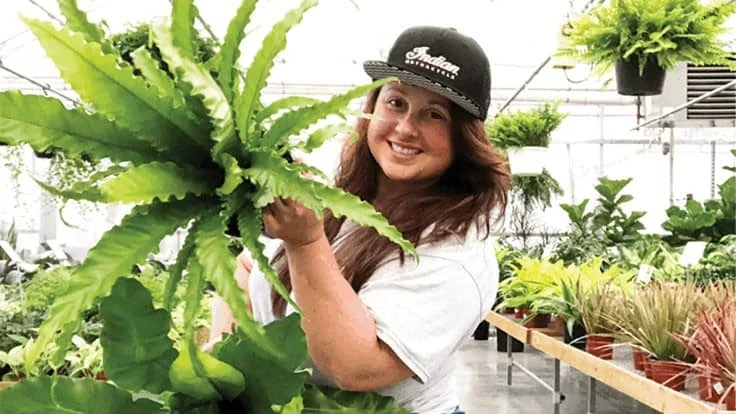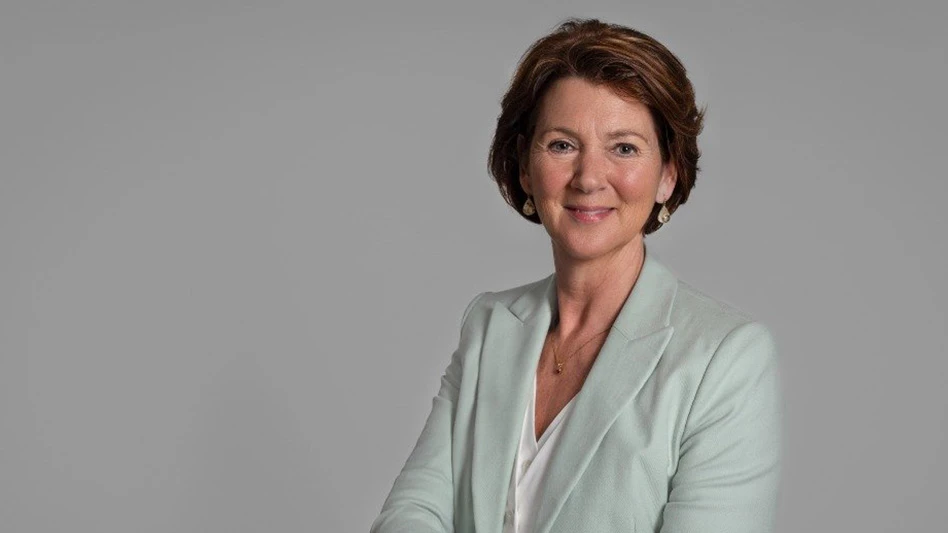

All the rage in the ‘70s, houseplants fell out of favor in the subsequent decades. But they’re back with a vengeance. In the past three years, houseplant sales have grown by 50%, according to the National Gardening Association.
Some plants have become status symbols for Instagram “Plantfluencers,” driving their price tag into the three digit-range. The thrill of exclusivity motivates these social-media savvy plant parents to splurge on a pink princess philodendron or variegated monstera. Being able to post a “shelfie” of a rare find on social media is a powerful pull for younger millennials and Generation Z.
“The demand for houseplants has been steadily increasing over the last few years as plants have become cool again, thanks to social platforms like Instagram and YouTube,” says Maggie Bridge, manager of sales and marketing for Sam Bridge Nursery & Greenhouses.
At Sam Bridge, a Greenwich, Connecticut, institution and No. 37 on Garden Center magazine’s Top 100 list, demand has surged from both new and existing customers. Though the trend is a few years old, it noticeably ticked up a notch during the COVID-19 pandemic.
“During quarantine, there was definitely a push to green up personal spaces whether inside or out,” Bridge says. “For us, quarantine kicked in during the tail end of winter and we continued to have cold weather through May, which helped the houseplant trend.”
Jennifer Rolo handles all the buying for Weston Nurseries’ 300-acre garden center in Hopkinton, Massachusetts. She has seen a substantial increase in the demand for houseplants and she believes the trend is being driven by new customers. The new customers are part of a younger generation, she says, mostly living in apartments, and they’re buying plants for their indoor living spaces.
The opportunities for IGCs don’t end with the houseplant sales, though. Rolo says there has been a corresponding increase in sales in indoor accent pottery that correlates with the houseplant boom. Those first-time home buyers and even apartment-dwellers want to put a pot on their front step or patio.
“Most of the time when someone comes in for a houseplant, they want to buy a pot with it,” she says. “It goes hand in hand.”Where the rare plants are hiding
Rolo relies on her staff of 20-somethings in the greenhouse department to keep up with houseplant trends.
“They certainly keep me on my toes and they’re very much into houseplants,” she says. “I also take requests from them on what they find cool and interesting.”
Many of her orders are direct from Florida. She also uses her connections, from local contacts to brokers that help her find some of the more unusual, unique items that a big grower wouldn’t necessarily stock.
“I’m a plant geek myself,” she says. “I do my homework; I source vendors and go to other garden centers when I have time and I do look at their vendor tags on their pots, because that helps.”
Bridge also sources a lot of houseplants from Florida and credits a longstanding relationship with a broker who always seems to help them find what they want. Later in the season, when filling a truck becomes more difficult, the IGC turns to local sources. Bridge says there are some great places to find rare houseplants on Long Island and a few come out of Canada as well.
Sam Bridge tends to plan orders based of what sells best, though finding a grower that has some of the most popular Instagram plants in stock is like finding a $100 bill on the sidewalk.
“Anything new or cool we come across in the social world definitely makes it on the wish list — whether it’s actually available is another story,” she says.
She’s looking into sourcing exciting new plants from California, but shipping coast to coast is an expensive proposition.
“We’ve been making it work with what’s available, mixing up selections and so far the results have been great,” she says.
She says the Connecticut IGC has even had success adding houseplants they’d usually consider basic, like some palms and cordylines, if they’ve been out of the limelight for a season or two.
“If we haven’t carried it in some time, it still has that ‘new and cool’ feeling for both staff and customers,” she says. “There’s still plenty to be excited about.”

How to price rarity
Dr. Bridget Behe, professor of horticultural marketing at Michigan State University, says retail pricing for rare plants complies with the law of supply and demand. If you only have two or three of a particular plant in your inventory, you only need a couple of buyers to sell out.
“Pick a number that you think is obscenely high, not thousands of dollars, but you need to test the waters,” she says. “Even the markups of three, five, 10, 50 times the price, these rules don’t really apply when you’ve got something novel and unique.”
If the plant sits for a few weeks, you can always bring the price down, Behe says. A decent point-of-sale system will let you change prices at the drop of a hat, without the appearance of putting it on sale. She urges IGCs to let a rare plant’s scarcity and popularity work for them and not to let it slip away too quickly.
“Are you the only one that has that plant? Well, you’ve got an opportunity to really make some money from somebody who really badly wants that plant,” she says. “Don’t be afraid to put what you would consider to be an extraordinarily high price on that and see what happens. But the only way you’ll know is to try it. And if you go in too low and it sells the next day, I think you’ve really lost an opportunity to make a profit.”
At Weston Nurseries, Rolo audits the competition before pricing. There are a lot of IGCs in Massachusetts as well as the big-box stores, and she shops around to see where they stand. But a hard-to-acquire plant will cost more.
“If it is a rare or unusual specimen or a difficult plant to get, we do charge more,” she says. “We price what we feel that it’s worth and being plant geeks and experts, I think that we come up with a good middle ground of what we might pay for it.”
At Sam Bridge, pricing is usually based off what they pay for the material. But if a plant arrives looking incredible and the IGC staff thinks they can get more for it, it will get a bump.

“Formulas are great on paper, but nothing can compare to double-checking that material in person and asking yourself if that calculated price makes sense,” Bridge says.
Rolo sees the houseplant boom as an opportunity for IGCs to differentiate themselves from the big-box competition, which rarely stocks any plants that could be categorized as rare or unusual — certainly nothing that would inspire envy on Instagram or among the 365,000 members of the Reddit houseplants community.
“You have your bread and your butter and your milk at box stores,” she says. “But at the garden centers you have all the other goodies.”
IGCs can be the destination for the savvy shoppers who want the hot plant they can’t find anywhere else — and are willing to pay a premium for it. A plant specialist who can track down a rare item builds trust and customer loyalty.
“The trust is a big selling point because even if our price may be slightly higher for an item like bread, our customers still will come back to us and buy that bread because they trust that they’re going to be successful and they can get the guidance,” Rolo says. “They can come back to us and say, ‘How come this didn’t work?’ versus not having that personal connection with anybody in the box stores.”
The opportunity is there for IGCs to seize. Because of the quarantines, more people are turning to gardening and many IGCs have had a huge spring. Planters and raised beds have been incredibly popular at Sam Bridge and soil has been next to impossible to keep in stock. Maggie Bridge says the IGC has shortages that won’t be filled until the fall or even next year.
“With more and more people staying home than ever before, every DIY project is now within reach,” she says. “People want to get their hands dirty whether it’s inside or out and our industry has a golden opportunity. We finally have the audience we’ve been waiting for so it’s up to us to show them how cool plants are.”
Behe concurs and underscores the opportunity for IGCs to maximize their profits on these hot items.
“We need to be brave,” Behe says. “We need to be thinking about the potential profitability for that plant. The tendency is to underestimate the value of the plant. If consumers were rational, economists would rule the world, but people are not rational and some people will pay what you might consider to be an exorbitant price for a plant.”

Explore the September 2020 Issue
Check out more from this issue and find your next story to read.
Latest from Greenhouse Management
- Grant awarded to test western U.S. wood species for use as wood fiber potting substrate
- Pennsylvania Horticultural Society announces 2025 Gold Medal Plant winners
- Oasis Grower Solutions announces new Southeast territory sales manager
- A nation of gardeners: A history of the British horticulture industry
- Last Word with Angela Labrum, Bailey Nurseries
- Iowa plant supplier Plantpeddler building retail complex
- This month's Greenhouse Management magazine is about native plants and sustainability
- The HC Companies, Classic Home & Garden merge as Growscape





